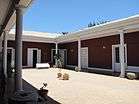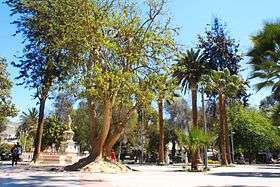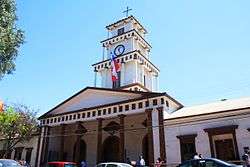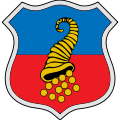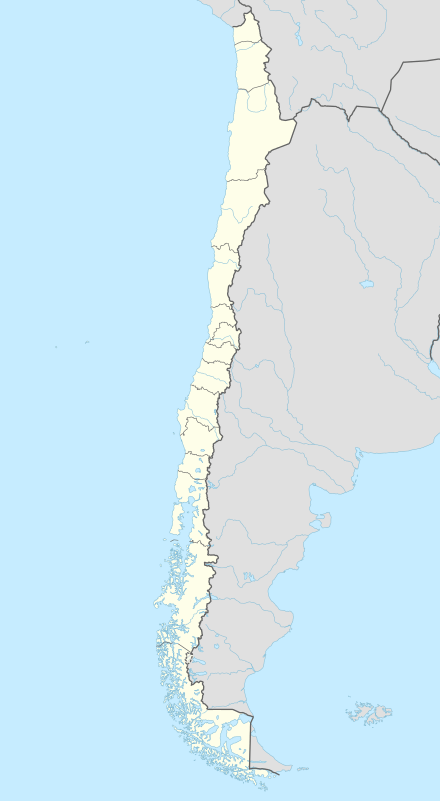Copiapó
| Copiapó | |||||||
|---|---|---|---|---|---|---|---|
| City and Commune | |||||||
| |||||||
| |||||||
| Coordinates: 27°21′59″S 70°19′59″W / 27.36639°S 70.33306°WCoordinates: 27°21′59″S 70°19′59″W / 27.36639°S 70.33306°W | |||||||
| Country |
| ||||||
| Region |
| ||||||
| Province | Copiapó | ||||||
| Founded | December 8, 1744 | ||||||
| Founded by | José Antonio Manso de Velasco | ||||||
| Government[1][2] | |||||||
| • Type | Municipality | ||||||
| • Alcalde | Maglio Cicardini (IND) | ||||||
| Area[3] | |||||||
| • Total | 16,681.3 km2 (6,440.7 sq mi) | ||||||
| Elevation | 390 m (1,280 ft) | ||||||
| Population (2012)[3] | |||||||
| • Total | 158,438 | ||||||
| • Density | 9.5/km2 (25/sq mi) | ||||||
| Time zone | CLT (UTC−4) | ||||||
| • Summer (DST) | CLST (UTC−3) | ||||||
| Postal code | 1530000 | ||||||
| Area code(s) | (+56) 52 | ||||||
| Climate | BWk | ||||||
| Website |
www | ||||||
Copiapó (Spanish pronunciation: [kopjaˈpo]) is a city in northern Chile, located about 65 kilometers east of the coastal town of Caldera. Founded on December 8, 1744, it is the capital of Copiapó Province and Atacama Region.
Copiapó lies about 800 km north of Santiago by the Copiapó River, in the valley of the same name. In recent years, the river has dried up. The town is surrounded by the Atacama Desert and receives 12 mm (½ in) of rain per year. The population of Copiapó was 9,128 in 1903, 11,617 in 1907 and, as of 2012, there are 158,438 inhabitants.
Copiapó is in a rich silver and copper mining district. It possesses a bronze statue of Juan Godoy, discoverer of the Chañarcillo silver mines in the 19th century. The Copiapó-Caldera railway line, built in 1850, was the first one in South America. The first section between Caldera and Monte Amargo was inaugurated on July 4 of 1850 in honour of the nationality of William Wheelwright, the American business man responsible for the project. The original wooden railway station is now a National Monument.
History
The town was christened San Francisco de la Selva de Copiapó or Saint Francis of the Jungle of Copiapó, due to its lush vegetation. Prior to Spanish occupation, the area was inhabited by the Diaguita people under the rule of the Inca Empire. The earliest archaeological remains of human activity in the Copiapó Valley have been dated at ten thousand years BP.
Copiapó was, until the annexation of Antofagasta and Iquique during the War of the Pacific (1879–1883), Chile's northernmost city and main mining city.
On 5 August 2010, a copper/gold mine collapsed, leaving 33 miners trapped underground. The miners survived underground for 69 days until their rescue on 13 October 2010, a record period of time.
Demographics
According to the 2002 census of the National Statistics Institute, Copiapó had 129,091 inhabitants (64,922 men and 64,169 women). Of these, 125,983 (97.6%) lived in urban areas and 3,108 (2.4%) in rural areas. The population grew by 27.9% (28,184 persons) between the 1992 and 2002 censuses.[3]
According to the same census, the religious affiliation in Copiapó, is the following:
- 75.97% Roman Catholicism
- 10.74% Protestantism
- 1.29% The Church of Jesus Christ of Latter-day Saints
- 1.25% Jehovah's Witnesses
- 0.04% Judaism
- 0.03% Islam
- 0.02% Greek Orthodoxy
- 3.56% Other
- 7.10% None, atheism or agnosticism.
Climate
Copiapó has a desert climate (Köppen: BWk) with mild temperatures year round.[4] Winters are mild with warm temperatures during the day, with a July maximum of 19.3 °C (66.7 °F) and cool temperatures during the night, averaging 7 °C (44.6 °F). Temperatures rarely fall below freezing. Most of the precipitation falls during this time of the year with June and July being the wettest months.[5] While winters are normally dry, precipitation is highly variable. This was the case when June 1998 recorded 68 millimetres (3 in) of precipitation but generally, in most years, precipitation is rare.[5] Summers are warm with a January average of 22.2 °C (72.0 °F) and precipitation is virtually non-existent.[5] Temperatures can occasionally exceed 30 °C (86.0 °F) anytime of the year. The average annual precipitation is 18.8 millimetres (1 in) though this is highly variable with some years recording no precipitation such as in 1970, 1978, 1990, 1992-1993 and in 1998 and other years where precipitation is recorded.[5] There are 3.2 days with measureable precipitation. The record high was 34.0 °C (93.2 °F) in August 1972 and the record low was −2.0 °C (28.4 °F) in June 1975.[5]
| Climate data for Copiapo | |||||||||||||
|---|---|---|---|---|---|---|---|---|---|---|---|---|---|
| Month | Jan | Feb | Mar | Apr | May | Jun | Jul | Aug | Sep | Oct | Nov | Dec | Year |
| Record high °C (°F) | 33.8 (92.8) |
31.6 (88.9) |
32.4 (90.3) |
31.8 (89.2) |
31.4 (88.5) |
33.4 (92.1) |
32.8 (91) |
34.0 (93.2) |
32.7 (90.9) |
32.4 (90.3) |
32.2 (90) |
31.4 (88.5) |
34.0 (93.2) |
| Average high °C (°F) | 27.5 (81.5) |
27.5 (81.5) |
26.1 (79) |
23.5 (74.3) |
21.3 (70.3) |
19.6 (67.3) |
19.3 (66.7) |
20.3 (68.5) |
21.8 (71.2) |
23.3 (73.9) |
24.7 (76.5) |
26.4 (79.5) |
23.4 (74.1) |
| Daily mean °C (°F) | 22.2 (72) |
22.0 (71.6) |
20.6 (69.1) |
18.2 (64.8) |
16.1 (61) |
14.5 (58.1) |
14.0 (57.2) |
14.9 (58.8) |
16.3 (61.3) |
17.7 (63.9) |
19.1 (66.4) |
21.0 (69.8) |
18.0 (64.4) |
| Average low °C (°F) | 15.5 (59.9) |
14.9 (58.8) |
14.0 (57.2) |
11.9 (53.4) |
9.6 (49.3) |
7.8 (46) |
7.3 (45.1) |
8.2 (46.8) |
9.5 (49.1) |
10.8 (51.4) |
12.5 (54.5) |
14.3 (57.7) |
11.3 (52.3) |
| Record low °C (°F) | 7.0 (44.6) |
2.5 (36.5) |
1.4 (34.5) |
3.4 (38.1) |
0.4 (32.7) |
−0.6 (30.9) |
−2.0 (28.4) |
−0.6 (30.9) |
0.8 (33.4) |
0.6 (33.1) |
1.5 (34.7) |
2.4 (36.3) |
−2.0 (28.4) |
| Average precipitation mm (inches) | 0.0 (0) |
0.1 (0.004) |
1.2 (0.047) |
1.0 (0.039) |
1.5 (0.059) |
5.6 (0.22) |
5.6 (0.22) |
3.4 (0.134) |
0.3 (0.012) |
0.1 (0.004) |
0.0 (0) |
0.0 (0) |
18.8 (0.74) |
| Average precipitation days | 0.0 | 0.0 | 0.2 | 0.2 | 0.5 | 0.8 | 0.6 | 0.4 | 0.3 | 0.1 | 0.1 | 0.0 | 3.2 |
| Average relative humidity (%) | 60 | 61 | 63 | 66 | 67 | 66 | 65 | 65 | 63 | 61 | 60 | 59 | 63 |
| Mean monthly sunshine hours | 294.5 | 259.9 | 263.5 | 201.0 | 198.4 | 192.0 | 217.0 | 220.1 | 237.0 | 269.7 | 276.0 | 291.4 | 2,920.5 |
| Mean daily sunshine hours | 9.5 | 9.2 | 8.5 | 6.7 | 6.4 | 6.4 | 7.0 | 7.1 | 7.9 | 8.7 | 9.2 | 9.4 | 8.0 |
| Source #1: Dirección Meteorológica de Chile[5] | |||||||||||||
| Source #2: Universidad de Chile (sunshine hours only)[6] | |||||||||||||
Economy
Copiapó has a diversified and potential economy, but mining is the largest economic activity.[7]
The Copiapó Basin has a great deal of copper ore, mined by companies such as Minera Candelaria, which extracts copper near Tierra Amarilla, a neighboring commune. This generates a need for transportation, light industry, and services. "Small mining" represents over 30% of the production. The copper obtained by pirquineros (miners) goes to the copper smelter at Paipote.
Agriculture is the second largest source of income in this area. It consists largely of grape production, with olives, tomatoes, avocados and some citrus fruits also playing a part.
Industry: Copiapó has mainly light industry, and some medium industry such as the INACESA plant and Paipote copper refinery.
Energy: Many important solar plants were built in the Atacama Region, benefiting from the high and constant solar radiation along the year.[8] Solar photovoltaic energy production reached for 2016 to more than 400 MW connected to the Central-North grid.
Commerce is growing in Copiapó, largely old and new small and medium enterprises. Downtown Copiapó activity mirrors Copiapó's progress. Some native enterprises have grown rapidly in the last decade such as the Albasini and Don Álvaro chain-stores. Free-market policies along with a higher demand and better economic expectations have encouraged the arrival of big, national enterprises such as the supermarkets Deca (1999), Jumbo (2005), and Lider (2006).
Tourism in Copiapó has been developing in the last years. An example of this is the new Casino, and the new infrastructures hotels had to invest in, due to the excess of demand by domestic and foreign tourists.
Significant attractions of Copiapó are the Mineralogic Museum, Plaza de Armas, Regional Museum of the Matta Family, the Wooden Railway Station, the San José Cooper Mine (closed in 2010); in the coast, Totoralillo, Totoral and the zone of "Travesía", wherein after rain, occurs the so-called "Desierto Florido"; in the Andes, the Ojos del Salado volcano, and the lakes Green and Negro Francisco, and also the Tres Cruces National Park.

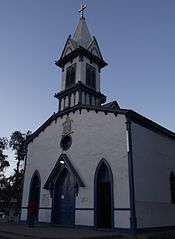
Administration
Municipal Government
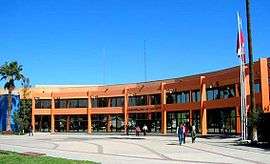
As a commune, Copiapó is a third-level administrative division of Chile administered by a municipal council, headed by an alcalde who is directly elected every four years. The 2012-2016 alcalde is Maglio Cicardini (Independent). The council has the following members:[1][2]
- Magaly Milla Montaño (Independent)
- Luis Orrego Salinas (Independent)
- Rosa Ahumada Campusano (PC)
- José Bernardino Fernández Quevedo (PPD)
- Omar Luz Hidalgo (Independent)
- Anelice Véliz Kratzschmar (PS)
- Mario Enrique Bordoli Vergara (RN)
- Juan Carlos Mellibosvky Leiva (RN)
Brief History of Recent Municipal Politics
Since the return to democracy in 1990, there have been six mayoral elections held in Copiapó.
In 1992,[9] Mónica Calcutta (PPD) won the election against 24 candidates. Her term was characterized by public expenditures on green areas, parks, and street paving, and public infrastructure such as the new building of the City Hall (1994), the Estadio Techado (1996), and the Technological School (inaugurated in 1997). During her term, Calcutta encouraged people to participate. One of these activities was the "Train of History" carried out in 1994 (for the 250th anniversary of Copiapó) and 1995.
Despite all these expenditures, the City Hall ended up with no debt for 1996.
In 1996,[10] Calcutta ran for the re-election, but was defeated by the socialist candidate Marcos López (city councilor 1992–1996) by a narrow margin of 146 votes. López's term differed substantially from Calcutta's; his first three years as mayor did not see any important public expenditures in visible things. They came out the year before the following election.
The 2000 election was a very confrontational one. López and Calcutta ran for election together with 10 other candidates. In spite of surveys that showed a virtual tie between them, López won the election with an overwhelming 50.07% of the votes to his rival's 31.52%.[11]
López's second term in office was characterized by high public expenditures, part of it from the Central Government to improve Chilean infrastructure toward the bicentennial of Independence. These expenditures went towards redesigning the Central Square, Matta Avenue and the City Chamber.
In 2004, Marcos López was elected to another term, defeating the rightist candidate René Aedo (RN) with 50.01% to 40.82% of the votes.[12]
In 2008, López run for a fourth term, but was defeated by the independent candidate Maglio Cicardini Neyra, by a margin of less than 1% of the votes.
In 2012, López run once again, but lost against Cicardini, who won the election with more than 50% of the votes.
Congressional Representation
Within the electoral divisions of Chile, Copiapó is represented in the Chamber of Deputies by Lautaro Carmona (PC) and Daniella Cicardini Milla (Independent, backed up by the PS) as part of the 5th electoral district, (together with Chañaral and Diego de Almagro). The commune is represented in the Senate by Isabel Allende Bussi (PS) and Baldo Prokurica Prokurica (RN) as part of the 3rd senatorial constituency (Atacama Region).
Education
Copiapó provides public and private education, from kindergarten to high school, and also technical and bachelor's degrees.
Schools
According to the Departament of Education of Chile, Copiapó had (2007) an enrollment of more than 35.000 students, divided in the following programs: Kindergarten, 3.780 students; Differencial Education, 1.009 students; Elementary and Middle School, 20.794 students; High School, 10.291 students (5.185 in Scientific-Humanist programs and 5.106 in Technical-Professional programs).[13]
La commune of Copiapó offers public and private education held by 64 schools, divided in: 61 urbans and 3 rurals; 32 public, 23 State-subsidized private schools and 9 private schools.[14]
Universities
- Universidad de Atacama[15] was founded in 1857, and is the only public university in the Third Region.
- Universidad Santo Tomás (Copiapó)
- Universidad Tecnológica de Chile, INACAP (Copiapó)
Professional Institutes
- Instituto Tecnológico UDA (public)
- Santo Tomás (private)
- Inacap (private)
- Iplacex (private)
Technical Centers of Study
- CFT Benjamín Teplizky (private)
- CFT Santo Tomás (private)
- CFT Inacap (private)
- CFT Cepa (private)
Sports & Recreation
Soccer

This city has a soccer team called Club de Deportes Copiapó, which was born after the dissolution of Regional Atacama, in 1999. It plays in the Primera B League of Soccer of Chile, and plays as local in the Luis Valenzuela Hermosilla Stadium and in the Municipal Stadium of Tierra Amarilla.[16]
Raid Atacama
This is the event that gathers the most 4x4 automobiles in the world, and it began in 1992.
The effort and spirit of Raid Atacama has made it worthy of the National Award for Tourism. For over 21 years, the Atacama Raid has been the cornerstone of the development of off-road activities along Chile, and its example has been followed by many clubs and even several companies.
In the last seven years, the enrollment has kept steady on an average of about 500 vehicles per event, and more than 1,800 participants from all regions of the country and abroad.
In 1997, it reached the largest number of participants to date, bringing together 613 4x4 vehicles. With no other event as large, this made it possible to apply for registration as a world record. Another of the achievements is to hold, without competition, the record for international off-road event (amateur) with greater permanence in time.
Rally Dakar
In the last years, Copiapó has been not only one of the Chilean communes the Rally Dakar Chile-Argentina has passed through, but also the place of birth of Jaime Prohens, one of the most importants runners of this rally.[17]
Copiapó UFO sighting
Copiapó was said to be the site of an unidentified flying object sighting in 1864. According to researcher Chris Aubeck,[18] the story first appeared in print in the March 18, 1868 issue of the newspaper El Constituyente, which was itself cited in the journal The Zoologist then in Lo!, a 1931 book by American investigator Charles Fort. Fort's account was the basis of a later account in Anatomy of a Phenomenon (1965) by ufologist Jacques Vallee.
Sister cities
See also
References
- 1 2 "Municipality of Copiapó" (in Spanish). Retrieved 28 July 2010.
- 1 2 "Asociación Chilena de Municipalidades" (in Spanish). Retrieved 27 January 2011.
- 1 2 3 "National Statistics Institute" (in Spanish). Retrieved 3 November 2010.
- ↑ Kottek, M.; J. Grieser; C. Beck; B. Rudolf; F. Rubel (2006). "World Map of the Köppen-Geiger climate classification updated" (PDF). Meteorol. Z. 15 (3): 259–263. doi:10.1127/0941-2948/2006/0130. Retrieved January 12, 2013.
- 1 2 3 4 5 6 "Estadistica Climatologica Tomo I (pg 279-300)" (PDF) (in Spanish). Dirección General de Aeronáutica Civil. March 2001. Retrieved January 12, 2013.
- ↑ "Tabla 4.6: Medias mensuales de horas de sol diarias extraídas del WRDC ruso (en (hrs./dia))" (PDF). Elementos Para La Creación de Un Manual de Buenas Prácticas Para Instalaciones Solares Térmicas Domiciliarias (in Spanish). Universidad de Chile. September 2007. p. 81. Retrieved 21 January 2015.
- ↑ Secretaría Regional Ministerial de Economia Región de Atacama ::
- ↑
- ↑ Sistema De Despliegue De Computos - Ministerio Del Interior
- ↑ Sistema De Despliegue De Computos - Ministerio Del Interior
- ↑ Sistema De Despliegue De Computos - Ministerio Del Interior
- ↑ Sistema De Despliegue De Computos - Ministerio Del Interior
- ↑ Sistema de Información de Estadísticas Educativas SIEE. Ministerio de Educación de Chile
- ↑ Mineduc - Directorio de establecimientos educacionales
- ↑ http://www.uda.cl
- ↑
- ↑
- ↑ http://www.ufoupdateslist.com/2004/mar/m21-016.shtml
External links
-
 Media related to Copiapó at Wikimedia Commons
Media related to Copiapó at Wikimedia Commons - Municipality of Copiapó (Spanish)

